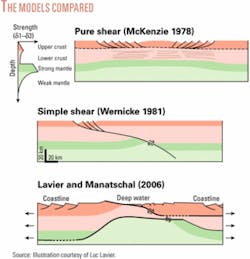With much attention focusing on improved recovery, smart completions, and other methods for coaxing hydrocarbons out of places where they are known to occur, it’s easy to forget that humankind still looks for oil and gas where their existence isn’t assured.
For that reason, Oil & Gas Journal in 2004 began a series of annual special reports called Exploration & Development Frontiers. The third special in the series appears in this issue (p. 29).
Frontiers in OGJ’s series are mostly geographic: regions off the beaten production path where somebody’s risking money on the hope of finding oil and gas. But geography seldom tells the whole exploration and development story. Breakthrough concepts about the subsurface have yielded great quantities of oil and gas over the years.
Ocean formation
Scientists at the University of Texas at Austin and Université Louis Pasteur of Strasbourg, France, have developed what they think is a breakthrough concept for explaining how continents break apart to form oceans. The concept should help deepwater oil and gas exploration.
Luc Lavier, a research associate at the Institute for Geophysics at UT’s Jackson School of Geosciences, and Gianreto Manatschal, a tectonics professor at the French university, developed the concept while studying inconsistencies in the explanations of tectonic models for the geology of deepwater ocean basins.
ExxonMobil Upstream Research Co. and Groupe de Recherche des Marges, a French academic consortium cosponsored by Total AS, supported the work, results of which appeared in the Mar. 16 edition of the journal Nature.
According to a UT press release, Lavier and Manatschal derived their new model for continental separation from experiments and geological reconstructions of the evolution of the ancient Alpine and present-day Atlantic margins.
The model accounts for complexities known to have occurred in the evolution of continental margins but unexplained by prevailing models, known as pure shear and simple shear. Those models explain features near continental coasts but not geology of deep oceans. They fail, for example, to explain the formation of volcanic seafloor in deep oceans through mantle-melting.
The model proposed by Lavier and Manatchal explains deepwater mantle-melting and phenomena at the edges of continental margins. In it, a fault in the crust and another in the mantle work together to thin the lithosphere and uplift the mantle (see figure).
“These faults behave like a conveyor belt pulling up lower crust and mantle,” the UT statement explains.
“Our model represents a shift in the way we understand the evolution of deformation and Earth’s material properties during extension of the continental lithosphere,” Lavier says in the statement.
Heat distribution
The model also revises the concept of heat distribution in offshore sedimentary basins containing deepwater oil and gas reserves.
Lavier calls refinement of the ability to assess temperature history “critical in areas such as the South Atlantic where oil exploration is taking place in deeper waters.”
The researchers next will return to the field to seek geological features predicted by their model. Call it exploration and development on the intellectual frontier.✦


